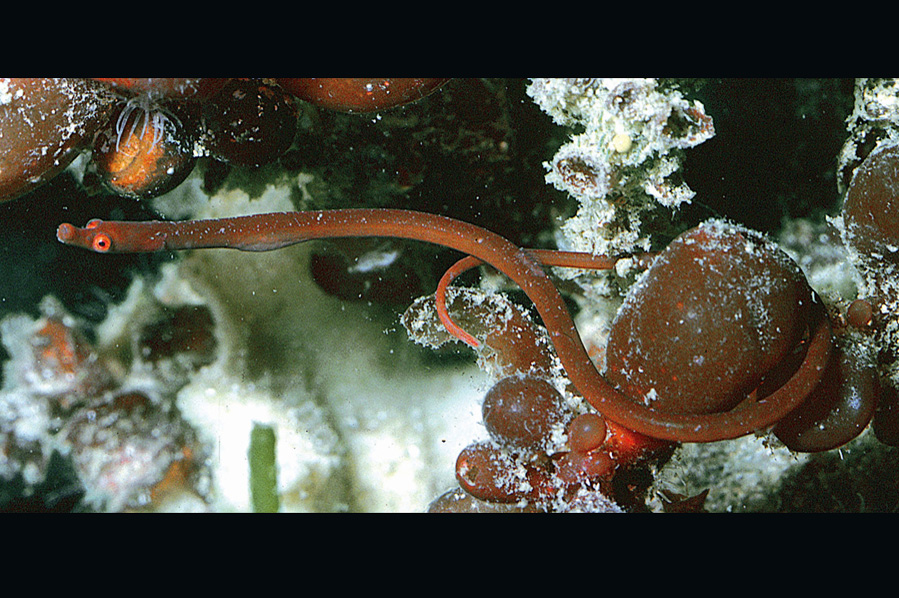Red Pipefish, Notiocampus ruber (Ramsay & Ogilby 1886)

A Red Pipefish, Notiocampus ruber, at Bicheno, Tasmania, depth 20 m. Source: Rudie H. Kuiter / Aquatic Photographics. License: All rights reserved
A dusky pink, red or maroon pipefish peppered with minute whitish to yellowish or reddish dots, a short snout, large eyes, and no pectoral fins. This secretive pipefish lacks pectoral fins and moves rapidly in a snake-like motion.
Red Pipefish, Notiocampus ruber (Ramsay & Ogilby 1886)
More Info
|
Distribution |
|
|
Features |
Dorsal fin 11–13; Caudal fin 6–7; Trunk rings 18–19; Tail rings 42–48; Subdorsal rings 0.00 + 1.25–1.50 = 1.25–1.50 Body very elongate, trunk shallow; head aligned with body; snout short, 35–39% HL; snout depth 30–32% snout length; dorsolateral profile of snout concave; median dorsal snout ridge low; opercle finely striate, without longitudinal ridge; ridges indistinct; superior trunk and tail ridges continuous; inferior trunk and tail ridges discontinuous near anal ring; lateral trunk ridge apparently not confluent with tail ridges; tail not prehensile. Dorsal fin much closer to head than to tip of tail, with short base; anal fin absent; caudal fin small, rounded; pectoral fin absent. |
|
Size |
To 160 mm SL. |
|
Colour |
Reddish, from dusky pink to a deeper maroon, with tiny red or yellow spots. |
|
Feeding |
Unknown, but likely to feed on small epibenthic invertebrates such as crustaceans. |
|
Biology |
|
|
Fisheries |
Of no interest to fisheries or aquaculture, although the Red Pipefish has been taken as bycatch in dredges. |
|
Conservation |
IUCN Red List Status: Least Concern Australian Commonwealth legislation: Marine listed under the Environment Protection and Biodiversity Conservation Act 1999 (EPBC Act). |
|
Remarks |
This cryptic species lacks pectoral fins, and moves over the substrate in a snake-like fashion. |
|
Similar Species |
The Red Pipefish, the only member of the genus Notiocampus, can be readily distinguished from other pipefishes in its region by the reddish coloration and lack of pectoral fins. |
|
Etymology |
The specific name is from the Latin ruber (= red), in reference to the red coloration of the species. |
|
Species Citation |
Nannocampus ruber Ramsay & Ogilby 1886, Proc. Linn. Soc. N.S.W. 10(4): 757. Type locality: Shark Reef, Port Jackson, New South Wales. |
|
Author |
Bray, D.J. & Thompson, V.J. 2020 |
|
Resources |
Red Pipefish, Notiocampus ruber (Ramsay & Ogilby 1886)
References
Dawson, C E. 1979. The Indo-Pacific pipefish genera Notiocampus gen. nov. and Nannocampus Günther. Proceedings of the Biological Society of Washington 92(3): 482-493. See ref at BHL
Dawson, C.E. 1985. Indo-Pacific Pipefishes (Red Sea to the Americas). Gulf Coast Research Laboratory, Ocean Springs, Mississippi. 230 pp.
Hamilton, H., Saarman, N., Short, G., Sellas, A.B., Moore, B., Hoang, T., Grace, C.L., Gomon, M., Crow, K. & Simison, W.B. 2016. Molecular phylogeny and patterns of diversification in syngnathid fishes. Molecular Phylogenetics and Evolution 107: 388-403 + supplement 1-4 + 5 https://doi.org/10.1016/j.ympev.2016.10.003
Kuiter, R.H. 1993. Coastal Fishes of South-eastern Australia. Crawford House Press, Bathurst, 437 pp.
Kuiter, R.H. 2009. Seahorses and their relatives. Aquatic Photographics, Seaford, Australia. Pp. 1–333.
Last, P.R., Scott, E.O.G. & Talbot, F.H. (1983). Fishes of Tasmania. Tasmanian Fisheries Development Authority, Hobart. 563pp.
Paxton, J.R., J.E. Gates, D.F. Hoese & D.J. Bray. 2006. Syngnathidae (Pp. 810–846). In Beesley, P.L. & Wells, A. (Eds) Zoological Catalogue of Australia. Volume 35. Fishes. ABRS & CSIRO Publishing, Australia., 3 vols.
Pogonoski, J.J., D.A. Pollard & J.R. Paxton. 2002. Conservation Overview and Action Plan for Australian Threatened and Potentially Threatened Marine and Estuarine Fishes, Environment Australia, Canberra. 375 pp.
Ramsay E.P. & J.D. Ogilby. 1886. Descriptions of two new fishes from Port Jackson. Proc. Linn. Soc. N.S.W. 10(4): 757-758. See ref at BHL
Whitley, G.P. 1941. Ichthyological notes and illustrations. Australian Zoologist 10(1): 1–50 figs 1–32 pls.
Zhang, X. & Pollom, R. 2016. Notiocampus ruber (errata version published in 2017). The IUCN Red List of Threatened Species 2016: e.T65372435A115431108. https://dx.doi.org/10.2305/IUCN.UK.2016-3.RLTS.T65372435A67624688.en. Downloaded on 30 September 2019.

